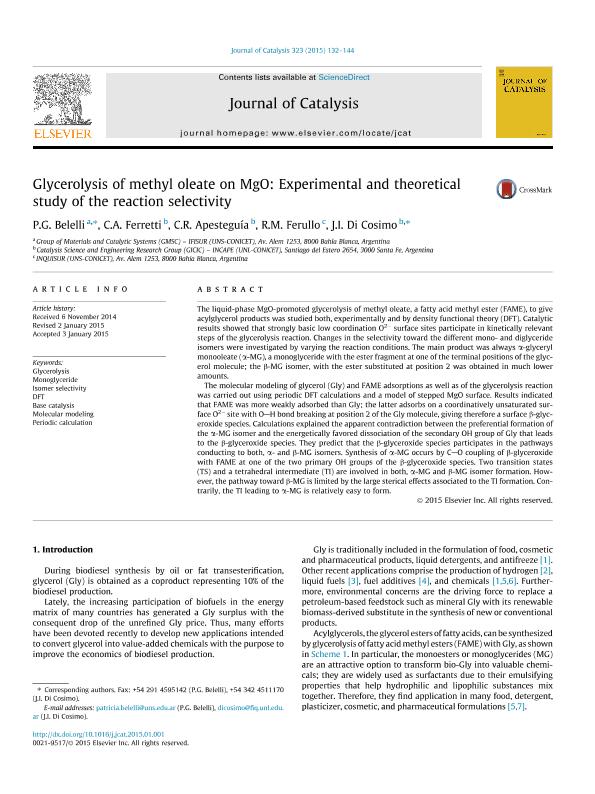Artículo
Glycerolysis of methyl oleate on MgO: experimental and theoretical study of the reaction selectivity
Belelli, Patricia Gabriela ; Ferretti, Cristián Alejandro
; Ferretti, Cristián Alejandro ; Apesteguia, Carlos Rodolfo
; Apesteguia, Carlos Rodolfo ; Ferullo, Ricardo
; Ferullo, Ricardo ; Di Cosimo, Juana Isabel
; Di Cosimo, Juana Isabel
 ; Ferretti, Cristián Alejandro
; Ferretti, Cristián Alejandro ; Apesteguia, Carlos Rodolfo
; Apesteguia, Carlos Rodolfo ; Ferullo, Ricardo
; Ferullo, Ricardo ; Di Cosimo, Juana Isabel
; Di Cosimo, Juana Isabel
Fecha de publicación:
01/2015
Editorial:
Elsevier
Revista:
Journal of Catalysis
ISSN:
0021-9517
Idioma:
Inglés
Tipo de recurso:
Artículo publicado
Clasificación temática:
Resumen
The liquid-phase MgO-promoted glycerolysis of methyl oleate, a fatty acid methyl ester (FAME), to give acylglycerol products was studied both, experimentally and by density functional theory (DFT). Catalytic results showed that strongly basic low coordination O2− surface sites participate in kinetically relevant steps of the glycerolysis reaction. Changes in the selectivity toward the different mono- and diglyceride isomers were investigated by varying the reaction conditions. The main product was always α-glyceryl monooleate (α-MG), a monoglyceride with the ester fragment at one of the terminal positions of the glycerol molecule; the β-MG isomer, with the ester substituted at position 2 was obtained in much lower amounts.
The molecular modeling of glycerol (Gly) and FAME adsorptions as well as of the glycerolysis reaction was carried out using periodic DFT calculations and a model of stepped MgO surface. Results indicated that FAME was more weakly adsorbed than Gly; the latter adsorbs on a coordinatively unsaturated surface O2− site with Osingle bondH bond breaking at position 2 of the Gly molecule, giving therefore a surface β-glyceroxide species. Calculations explained the apparent contradiction between the preferential formation of the α-MG isomer and the energetically favored dissociation of the secondary OH group of Gly that leads to the β-glyceroxide species. They predict that the β-glyceroxide species participates in the pathways conducting to both, α- and β-MG isomers. Synthesis of α-MG occurs by Csingle bondO coupling of β-glyceroxide with FAME at one of the two primary OH groups of the β-glyceroxide species. Two transition states (TS) and a tetrahedral intermediate (TI) are involved in both, α-MG and β-MG isomer formation. However, the pathway toward β-MG is limited by the large sterical effects associated to the TI formation. Contrarily, the TI leading to α-MG is relatively easy to form.
Palabras clave:
Mgo
,
Fatty Acid
,
Glycerolysis
,
Dft
Archivos asociados
Licencia
Identificadores
Colecciones
Articulos(IFISUR)
Articulos de INSTITUTO DE FISICA DEL SUR
Articulos de INSTITUTO DE FISICA DEL SUR
Articulos(INCAPE)
Articulos de INST.DE INVEST.EN CATALISIS Y PETROQUIMICA "ING. JOSE MIGUEL PARERA"
Articulos de INST.DE INVEST.EN CATALISIS Y PETROQUIMICA "ING. JOSE MIGUEL PARERA"
Articulos(INQUISUR)
Articulos de INST.DE QUIMICA DEL SUR
Articulos de INST.DE QUIMICA DEL SUR
Citación
Belelli, Patricia Gabriela; Ferretti, Cristián Alejandro; Apesteguia, Carlos Rodolfo; Ferullo, Ricardo; Di Cosimo, Juana Isabel; Glycerolysis of methyl oleate on MgO: experimental and theoretical study of the reaction selectivity; Elsevier; Journal of Catalysis; 323; 1-2015; 132-144
Compartir
Altmétricas



